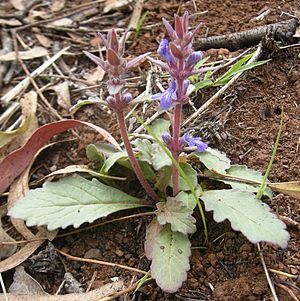Austral bugle facts for kids
Quick facts for kids Austral bugle |
|
|---|---|
 |
|
| Scientific classification | |
| Genus: |
Ajuga
|
| Species: |
australis
|
Ajuga australis, also known as the Austral bugle, is a pretty flowering plant. It is a native plant, meaning it naturally grows in Eastern Australia. A famous botanist named Robert Brown first described this plant. You might sometimes see it growing in gardens.
Contents
About the Austral Bugle
The Austral bugle is a small plant that isn't woody like a tree or bush. It has a stem that grows up from a group of leaves shaped like a rose. These leaves are usually 3 to 12 centimeters long. They are also 0.8 to 3.5 centimeters wide. The leaves have fine hairs, especially along the middle vein.
Flowers and Lifespan
This plant produces lovely purple flowers. You can mostly see them in spring, but they can bloom at other times too. Austral bugle plants usually live for about two to three years.
Where It Grows Naturally
The Austral bugle likes to grow in clay soils that have a lot of nutrients. You can find it in different types of soil, like those from Wianamatta Shale or basalt. In the Sydney area, it often grows in grassy woodlands. It can be found under trees like the narrow-leaved ironbark or forest red gum. It also grows alongside plants like kangaroo grass. Sometimes, it grows in open forests under trees such as black sally or snow gum.
Growing Austral Bugle in Your Garden
The Austral bugle is a great plant for gardens. It's quite easy to grow! You can plant it in spots that get some shade or even full sun. It can grow well in most types of soil. If you want more Austral bugle plants, you can easily grow new ones from cuttings.
- Austral bugle at the Encyclopedia of Life

